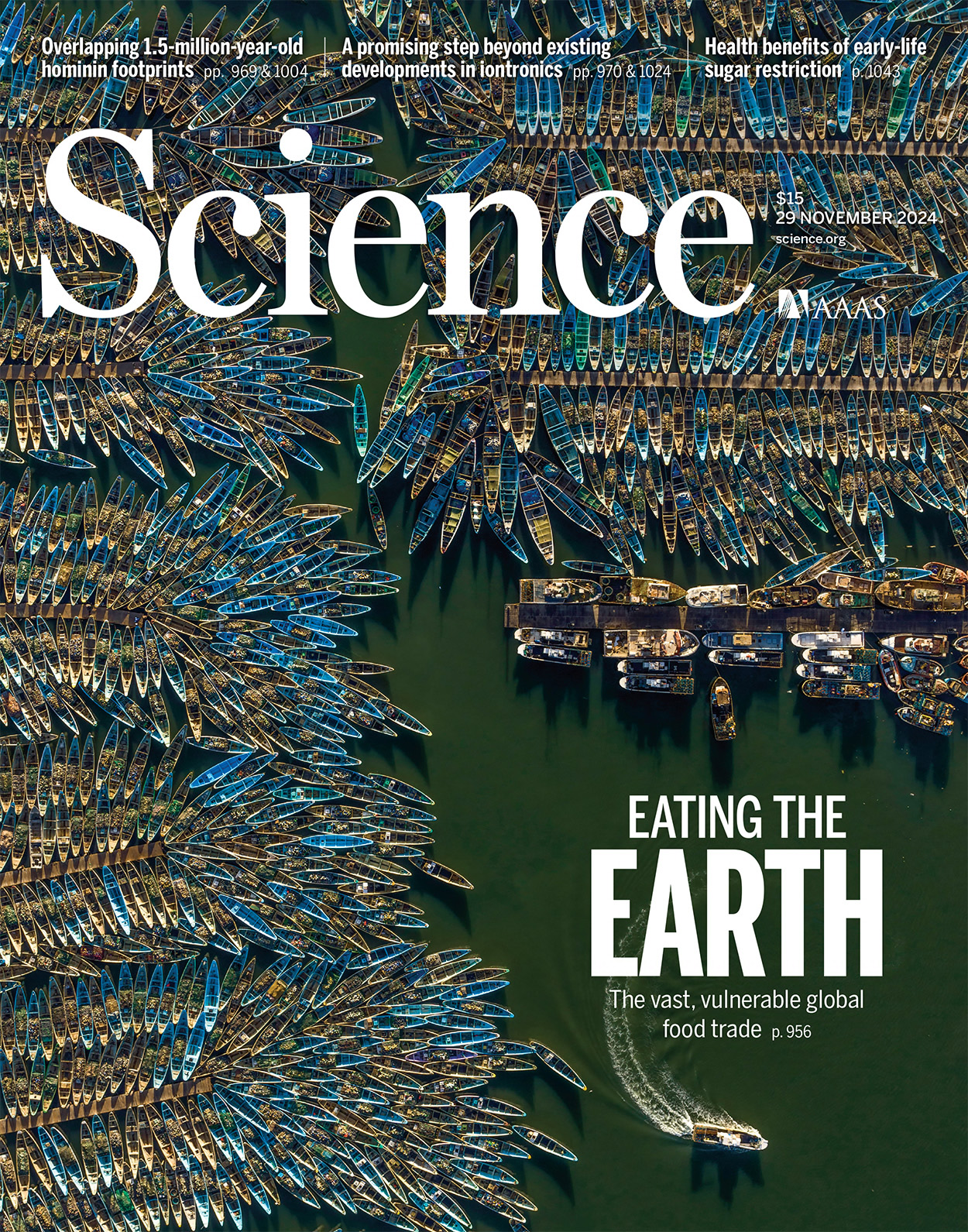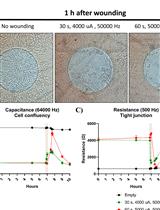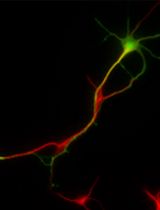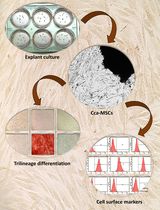- EN - English
- CN - 中文
Generation of Intestinal Epithelial Monolayers From Single-Cell Dissociated Organoids
由单细胞化类器官构建肠上皮单层
发布: 2025年10月05日第15卷第19期 DOI: 10.21769/BioProtoc.5474 浏览次数: 1371
评审: Wendy Leanne HempstockAnonymous reviewer(s)
Abstract
Intestinal organoids are generated from intestinal epithelial stem cells, forming 3D mini-guts that are often used as an in vitro model to evaluate and manipulate the regenerative capacities of intestinal epithelial stem cells. Plating 3D organoids on different substrates transforms organoids into 2D monolayers, which self-organize to form crypt-like regions (which contain stem cells and transit amplifying cells) and villus-like regions (which contain differentiated cells). This “open lumen” organization facilitates multiple biochemical and biomechanical studies that are otherwise complex in 3D organoids, such as drug applications to the cell’s apical side or precise control over substrate protein composition or substrate stiffness. Here, we describe a protocol to generate homogenous intestinal monolayers from single-cell intestinal organoid suspension, resulting in de novo crypt formation. Our protocol results in higher viability of intestinal cells, allowing successful monolayer formation.
Key features
• This protocol requires preexisting experience in culturing mouse intestinal organoids.
• This protocol requires preexisting experience in generating polyacrylamide (PAA) gels for culturing 2D monolayers.
• This protocol generates intestinal monolayers that can be subjected to additional analysis, e.g., drug treatment, immunofluorescent staining, single-molecule fluorescent in-situ hybridization (smFISH), or live imaging.
Keywords: Monolayers (单层)Background
The small intestine is one of the fastest renewing tissues in the body. Intestinal epithelial cells cover recurring units of crypts- invaginations into the intestinal stroma and villi finger-like protrusions that extend into the gut lumen. The crypts contain intestinal stem cells, Paneth cells, and transit amplifying cells. As cells exit the crypt, they differentiate into absorptive or secretory cell types. Intestinal epithelial cells adhere and migrate on the basement membrane, a sheet-like extracellular matrix. Both biochemical and mechanical cues, often originating in the extracellular matrix or surrounding cell types, maintain the behavior of the different cell populations along the crypt–villus axis during homeostasis [1,2].
The use of intestinal organoids emerged over a decade ago, as it was demonstrated that intestinal stem cells can form mini-guts–intestinal organoids, which recapitulate the stem cell–containing crypt-like compartment as well as regions of differentiated cells, similarly to cells covering the villi [3]. These organoids can be expanded indefinitely in 3D culture due to the self-renewing capacity of intestinal stem cells. While intestinal organoids are a powerful tool to investigate stem cell biology, their 3D closed lumen structure limits access to the cell’s apical surface, hinders solute transport studies, and makes it difficult to precisely control the extracellular environment, such as stiffness or protein composition.
To address these limitations, several methods have been developed to convert 3D organoids into 2D intestinal monolayers [4–7]. These use intestinal organoids as a starting material; when plated on a 2D structure, intestinal organoids will form a self-organizing 2D monolayer with crypt-like regions that contain stem cells surrounded by differentiated cells, mimicking the crypt–villus axis.
These monolayers allow easy drug or nutrient application, live imaging, and techniques such as transepithelial electric resistance (TEER) or electric cell-substrate impedance sensing (ECIS) [8–10]. Additionally, they enable controlled studies of mechanical cues by varying substrate stiffness or coating [11,12], for example, by using polyacrylamide (PAA) gels, and allow measurement of cellular forces via traction force microscopy [4].
Intestinal monolayers can be generated by plating small clumps of dissociated organoids. Alternatively, organoids can be dissociated into single cells, which then form monolayers through de novo crypt formation [4]. Here, we describe a robust protocol using Accumax or Accutase to dissociate organoids into single cells. This method improves cell viability and enhances the attachment efficiency of seeded cells. It enables the formation of uniform, self-organizing intestinal monolayers from either single or mixed cell populations. These monolayers can be used for various downstream applications, including drug treatments, live imaging, immunofluorescence, and smFISH. The same protocol also supports simple adhesion assays to assess cell-substrate interactions on different coatings.
Materials and reagents
Biological materials
1. Mouse intestinal organoids [13], grown in 50 μL Matrigel drops in a 24-well plate; see General note 1
Reagents
1. DPBS (Thermo Fisher scientific, catalog number: 14190136)
2. Gibco DMEM F12-Glutamax (Thermo Fisher scientific, catalog number: 11514436)
3. Gibco 100× antibiotic-antimycotic (Thermo Fisher scientific, catalog number: 15240096)
4. B27 supplement 50×, serum-free (Thermo Fisher scientific, catalog number: 17504001)
5. N2 supplement 100× (Thermo Fisher scientific, catalog number: 15410294)
6. Mouse EGF (Peprotech, catalog number: 17872513)
7. Mouse FGF (Peprotech, catalog number: 17844573)
8. Murine Noggin (Peprotech, catalog number: 250-38)
9. R-spondin (R&D Systems, catalog number: 3474-RS-050)
10. Nicotinamide (Sigma-Aldrich, CAS: 98-92-0)
11. Chir-99021 (Euromedex, catalog number: AB-M1692-100MG; CAS: 252917-06-9)
12. Rock inhibitor Y27632 (ATCC, catalog number: ATCC-ACS-3030)
13. Accumax (Sigma-Aldrich, catalog number: A7089)
14. Trypan blue stain (Invitrogen, catalog number: T10282)
15. Collagen I, rat tail, 100 mg (Corning, catalog number: 354236)
Solutions
1. Stock solutions
2. Cell dissociation solution (see Recipes)
3. Stop solution (see Recipes)
4. ENR medium (see Recipes)
5. Plating medium (see Recipes)
6. ENR-CNY medium (see Recipes)
Recipes
1. Stock solutions
| Reagent | Stock concentration | Solvent |
|---|---|---|
| Chir-99021 | 3 mM | DMSO |
| Y27632 | 1 mM | Distilled water |
| Nicotinamide | 1 M | Distilled water |
| EGF | 200 μg/mL | PBS |
| FGF | 100 μg/mL | PBS |
Aliquot and store at -20 °C.
2. Cell dissociation solution
| Reagent | Final concentration | Quantity or volume |
|---|---|---|
| Accumax | - | 1 mL |
| Chir-99021 (3 mM stock) | 3 μM | 1 μL |
| Y27632 (1 mM stock) | 10 μM | 1 μL |
For 12 Matrigel drops, 1 mL of dissociation solution is needed. Keep dissociation solution on ice. Make fresh each time.
3. Stop solution
| Reagent | Final concentration | Quantity or volume |
|---|---|---|
| DMEM F12-Glutamax | - | 1 mL |
| B27 50× | 1× | 20 μL |
| Chir-99021 (3 mM stock) | 3 μM | 1 μL |
| Y27632 (1 mM stock) | 10 μM | 1 μL |
For every 1 volume of dissociation solution, 2 volumes of stop solution are needed. For 1 mL of dissociation solution, 2 mL of stop solution is needed. Pre-heat the stop solution to 37 °C. Make fresh each time.
4. ENR medium
| Reagent | Final concentration | Quantity or volume |
|---|---|---|
| DMEM F12-Glutamax | - | - |
| Antibiotic-antimycotic | 2% | - |
| Mouse EGF | 10 ng/μL | - |
| Noggin | 100 ng/μL | - |
| R-spondin | 500 ng/μL | - |
| FGF | 10 ng/μL | - |
| N2 100× | 1× | - |
| B27 50× | 1× | - |
ENR medium can be kept at 4 °C for 2–3 weeks and will be used as the base medium for the monolayers throughout the experiment. Use 700 μL for each fluorodish.
5. Plating medium
| Reagent | Final concentration | Quantity or volume |
|---|---|---|
| ENR medium | - | - |
| Chir-99021 (3 mM stock) | 3 μM | - |
| Y27632 (1 mM stock) | 10 μM | - |
| - | - | 45–50 μL for each plate |
ENR medium can be kept at 4 °C for 2–3 weeks. Each gel should be plated with 45 μL of plating medium + cells. Add Chir and Y27 to the ENR medium at the needed volume right before plating.
6. ENR-CNY medium
| Reagent | Final concentration | Quantity or volume |
|---|---|---|
| ENR medium | - | - |
| Chir-99021 (3 mM stock) | 3 μM | - |
| Y27632 (1 mM stock) | 10 μM | - |
| Nicotinamide (1 M stock) | 10 mM | - |
| - | - | 700 μL for each plate |
Use this medium for cell spreading in the first 48–72 h. Use 700 μL for each fluorodish. Pre-heat to 37 °C. ENR medium can be kept at 4 °C for 2–3 weeks. Add Chir, Y27, and Nicotinamide to the ENR medium at the needed volume right before adding medium to the plated cells.
Laboratory supplies
1. 35 mm glass‐bottom dish (WPI FluoroDish FD35‐100) with 18 mm polyacrylamide gels (PAA), coated with collagen type-1 and washed with PBS, or any alternative substrate for cell attachment. See Baghdadi et al. [14], supplementary table. See General notes 2 and 3.
2. 20 G needle (TERUMO, catalog number: AN*2038R1)
3. 23 G needle (BD Microlance, catalog number: 300800)
4. 24 G needle (TERUMO, catalog number: NN-2425R)
5. 10 mL syringe (TERUMO, catalog number: MDSS10SE)
6. 2.5 mL syringe (TERUMO, catalog number: SS*02SE1)
7. Cell strainer 40 μm (FisherBrand, catalog number: 22363547)
8. 15 mL conical tubes (Sarstedt, catalog number: 62.554.002)
9. 50 mL conical tubes (Sarstedt, catalog number: 62.548.101)
10. 10 μL pipette tips (STARLAB, catalog number: S1121-2710)
11. 200 μL pipette tips (STARLAB, catalog number: S1120-8710)
12. 1,000 μL pipette tips (STARLAB, catalog number: S1122-1730)
Equipment
1. Laboratory centrifuge with rotors for 15 mL conical tubes, temperature-controlled, chilled to 4 °C (Eppendorf Centrifuge, model: 5804 R)
2. Cell incubator
3. Cell counter (DeNovix CellDrop FL counter)
4. Microscope for evaluating cell dissociation
Procedure
文章信息
稿件历史记录
提交日期: Jul 8, 2025
接收日期: Sep 2, 2025
在线发布日期: Sep 19, 2025
出版日期: Oct 5, 2025
版权信息
© 2025 The Author(s); This is an open access article under the CC BY-NC license (https://creativecommons.org/licenses/by-nc/4.0/).
如何引用
Felsenthal, N. and Vignjevic, D. M. (2025). Generation of Intestinal Epithelial Monolayers From Single-Cell Dissociated Organoids. Bio-protocol 15(19): e5474. DOI: 10.21769/BioProtoc.5474.
分类
干细胞 > 类器官培养
细胞生物学 > 细胞分离和培养 > 单层培养
您对这篇实验方法有问题吗?
在此处发布您的问题,我们将邀请本文作者来回答。同时,我们会将您的问题发布到Bio-protocol Exchange,以便寻求社区成员的帮助。
提问指南
+ 问题描述
写下详细的问题描述,包括所有有助于他人回答您问题的信息(例如实验过程、条件和相关图像等)。
Share
Bluesky
X
Copy link












